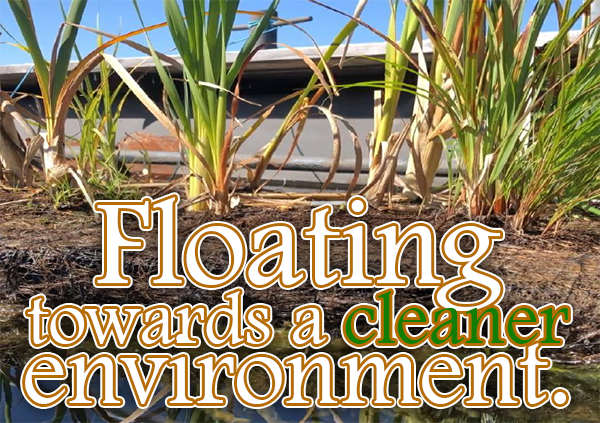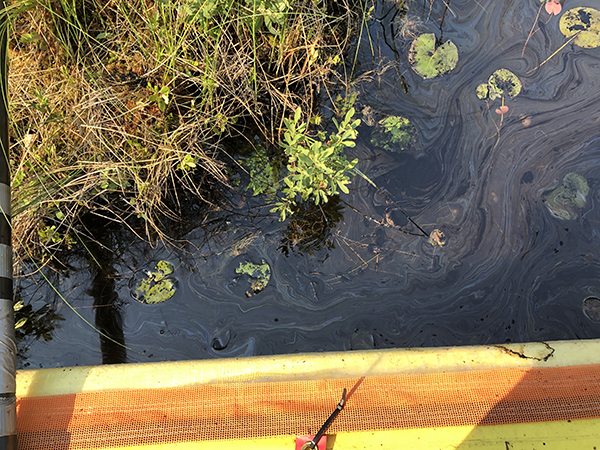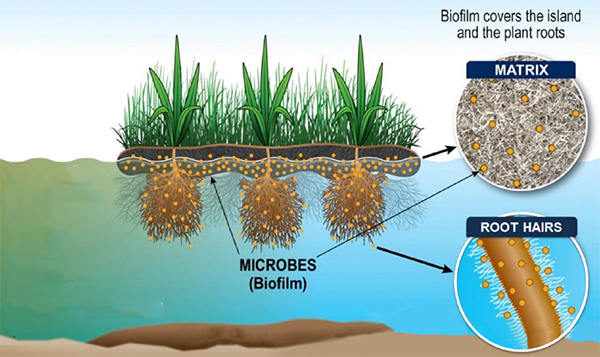
A floating engineered wetland, developed by the FLOWTER project team, could be a major breakthrough for remediating oil spills in remote freshwater systems. Photo by Madeline Stanley, courtesy IISD (International Institute for Sustainable Development).
While global energy suppliers focus on developing “net zero” sources to move humanity away from its dependency on carbon-emitting fossil fuels, using energy sources like oil isn’t likely to disappear any time soon. While renewable sources like wind, solar and geothermal continue to evolve, the extraction and transportation of fuel like oil and natural gas are expected to continue for many years. Further, fuels from resource-rich but remote sources like northern Alberta represent increased risks for accidents and spills.
In the past few years, high-profile accidents have occurred, including the notorious BP oil spill in the Gulf of Mexico in 2010, in which nearly 800 million litres of oil gushed into the ocean. Less publicized accidents that impacted freshwater sources include a 2022 oil leak from a steel mill in Sault Ste Marie, Ontario, which deposited 20,000 litres of oil into the St. Mary’s River. Further, with more than 800,000 km of oil and gas pipelines crisscrossing the country, the possibility for future incidents remains substantial.
Finding better ways of responding to and cleaning up fossil fuel spills is the catalyst for the Genome Prairie-sponsored FLOWTER project. Started in 2019, the FLOWTER project (which stands for Floating Wetland Treatments to Enhance Remediation) is now in its final research stages and uses a unique and innovative non-invasive approach to remediating oil spills in freshwater environments.
“The FLOWTER project is focused on the fundamental question, ‘Is there a better way of cleaning up oil spills?’” said academic lead Dr. Vince Palace. Speaking from his Winnipeg office, Palace serves as head research scientist at the International Institute for Sustainable Development – Experimental Lakes Area (aka IISD-ELA), a non-government entity with decades of experience conducting research in small lakes and watersheds in north-western Ontario.
Much of the research and experimentation done by ISSD-ELA correlates with a field of conservation that’s recently emerged as an urgent global issue – protecting sensitive freshwater resources. In 2019, a major United Nations study warned many of the world’s fragile ecosystems and biodiversity are under direct threat, mainly because of human actions. Highlighted in this study was the threat to the planet’s freshwater systems, with the report recommending the large-scale promotion of practices to reduce soil pollution near water supplies and the reduction of pollutants impacting lakes, rivers, and streams.
The FLOWTER project combines the power of genome sequencing with a biological-based approach toward degrading oil in fragile shoreline environments. A major focus of the project has been how microorganisms act and interact with oil contamination.
“When we started, the project asked the basic question, ‘Does the microbial community change when exposed to oil?’ The answer we know now is yes. ‘Are there bacteria in the system capable of degrading the oil?’ We also know the answer to this question is yes,” said Palace.
Knowing for sure that microorganisms consume oil was just part of the challenge. The project’s next big obstacle was providing the microorganisms with a comfortable home to do their thing.
“The issue is, if you can imagine oil penetrating a shoreline, the bacteria need certain elements to degrade that oil – they need oxygen while accessing sources of oil. In other words, they need circulation.”
The FLOWTER team’s innovative solution to the circulation challenge was developing floating engineered wetlands placed along shorelines. These floating vegetation pods act as nurturing homes to microorganisms as they go about “eating” up the oil.
“You have these floating platforms of vegetation, and underneath those platforms are very large root networks,” said Palace. “The roots provide an enormous surface area for bacteria to grow on with a big circulation of oxygen, nutrients, and the oil itself.
“The bacteria on the roots receive oxygen being pushed down by plants to their roots, while at the same time, the bacteria work to break down the oil.
“We are not adding microbes. We are not adding bacteria to the environment. We are simply stimulating the bacteria that are there already.”
The vulnerability of freshwater sources is especially apparent in Canada, whose territory is so large that the official number of freshwater sources is still debated. Some have estimated the country possesses roughly 850,000 lakes, although others have argued that the number is closer to 2 million. Most of Canada’s freshwater resources are in remote, difficult-to-reach areas.

An example of oil contamination in a freshwater environment. Photo by Lauren Timlick, courtesy IISD-ELA (International Institute for Sustainable Development – Experimental Lakes Area)
When events like oil spills happen in remote areas, it poses a big challenge for transporting crews and cleanup equipment to the affected location. Even after getting crews to a site, a major challenge is cleaning up any oil that’s found its way underground. Shorelines are especially vulnerable because the ground can be porous, meaning contaminants can find their way beneath the surface.
As part of the research and testing process, the FLOWTER team has replicated shoreline oil spills to better understand how contaminants spread and penetrate. “In these controlled experiments, we’ve waited four days for oil to interact with shorelines because that’s how long it could take a spill response team to reach a remote location,” said Palace.
“We’ve found that in four days in calm lake environments, oil infiltrates around 25 to 30 centimeters up onto the shore. Infiltration could reach ten times further up the shore in a higher energy environment like a large lake or river.”
“With current technology, when there’s an oil spill, there’s a lot of activity on the ground to recover that oil,” said Palace. “When a spill happens in a water environment, it’s easy to recover using skimmers, but when it reaches the shoreline, it is much more complicated and expensive because sometimes it means using heavy machinery to dig up contaminants from the ground.”
“The shoreline is very important. It’s the driver of productivity in lakes, rivers, and freshwater systems,” said Palace. Removing oil can be very difficult because it binds to the organic parts of the soil and the vegetation.
“What you’re often left with is an aggressive removal, a “dig and dump” type of operation. This can have severe physical ramifications on the shoreline that could take a decade or more to recover.
The project’s genomics part has mainly focused on understanding how capable microbial communities are of degrading oil to safe levels. “We’ve been looking at the genetics of the microbes to understand how effective they are,” said Palace. “Mainly, we’ve looked at how do microbes change and what are their capabilities for degrading the oil? Understanding that will help to determine how quickly the shoreline is remediated.”

An illustration by the IISD of how the engineered floating wetland works to remediate oil contaminants. Illustration courtesy IISD (International Institute for Sustainable Development).
Knowing how quickly the microbes act on oil is critical, especially for the FLOWTER project’s industry funders, including the Canadian Association of Petroleum Producers. When oil spills happen, time is of the essence – not only in reaching the spill location but in quickly taking measures to remove the contamination as quickly as possible.
“It’s great to say the microbes will degrade the oil, but if that process takes ten years, that’s not effective. However, if the microbes can remediate the oil in six months to a year, that’s a very attractive timeline.”
The efficiency of the engineered wetlands is exciting to industry because the cost savings from cleanup could be substantial. For example, a cleanup that costs $100M using conventional cleanup technologies could be a tenth of the price using a microbially mediated approach.
“In terms of a full difference, we know from a number of scenarios it’s far less costly to do the kind of remedial treatment using a less invasive approach like engineered wetlands than current invasive methods,” said Palace.
As the FLOWTER project enters its final months of testing and research, Palace reflected on how the project unearthed unexpected surprises about nature and its resilience.
“What surprised me was how quickly oil concentrations in the water column dissipated. I was surprised by the resilience of the natural systems and their ability to dampen the damage by the microbial responses.
I was, quite frankly, stunned by how quickly we were able to get the concentrations back to baseline. So we saw recovery where remaining concentrations posed little risk within 30 to 50 days, which I thought was astonishing.”
The FLOWTER project receives funding from Genome Canada through the Department of Innovation, Science and Economic Development (Government of Canada) and industry partners, including the Canadian Association of Petroleum Producers (lead receptor).

